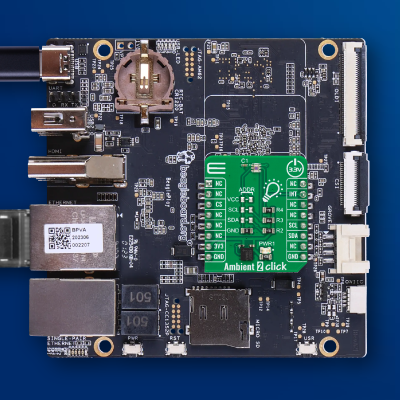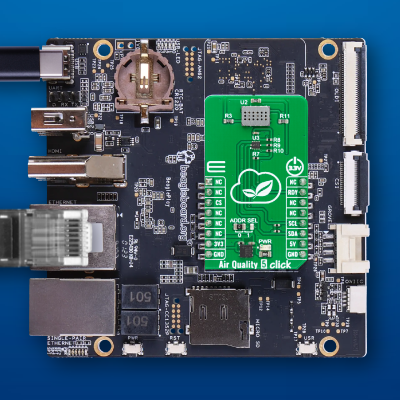Exploring ClickID
with BeaglePlay
Engineers worldwide explored how Click boards™ with ClickID feature can be integrated and used with the BeaglePlay! In the YouTube video above, Andrei Aldea put several Clicks to identification and functional test.
Understanding the ClickID Feature
ClickID is a feature designed to automatically recognize and configure Click boards™. This functionality reduces the setup time and complexity, enabling developers to focus on building their applications rather than dealing with hardware configuration issues. To better understand it, we are going to describe use case scenario from the video above.
ClickID Use Case
Driver Management
ClickID ensures that the appropriate drivers for the connected Click boards™ are loaded and managed by the Linux hardware monitoring tools. For instance, temperature sensors like the TMP 102 are managed by the `hwmon` tool, making it easy to read sensor data directly.
Automatic Recognition
When a ClickID enabled board is connected to BeaglePlay, the system automatically detects the board using specific identifiers. This detection process is typically handled by the system logs, which can be viewed using commands like `dmesg | grep "mikrobus".
Unified Access
All connected ClickID boards can be accessed through a standardized file system interface, usually found under `/sys/class/` or `/sys/bus/`. This unified interface simplifies the process of reading sensor data.
Practical Examples of ClickID in Action
THERMO 3 Click -
High-accuracy digital temperature sensor
Recognition: The system log shows the board is recognized via `dmesg | grep "mikrobus"`.
Access: The temperature can be read from `/sys/class/hwmon/hwmon0` using `cat temp1_input`.
ACCEL Click -
3-axis accelerometer
Recognition: Use `iio_info` to see the accelerometer connected as `device0 adxl 345`.
Access: Navigate to `/sys/bus/iio/devices/iio:device0` to read acceleration data.
AMBIENT 2 Click -
mimicking how humans see the light
Recognition: Verify connection with `iio_info`.
Access: Read ambient light data from the correct device path.
AIR QUALITY 5 CLICK -
Detect gas pollution for a number of different gases
Recognition: Verify connection with: `dmesg | grep "mikrobus"`.
Access: Since this board uses an ADC you will obtain raw sensor values. Navigate to the appropriate directory where the ADC readings are available: `cd /sys/bus/iio/devices/iio:device`. Replace `iio:deviceX` with the actual device number shown in your system. To read the raw air quality data, use: `cat in_voltageX_raw`.
OLED C Click -
small 96x96 high-color OLED display
Recognition: You can confirm connection with: `dmesg | grep "mikrobus"`.
Access: To use the OLED C Click as a display, you need `fbi` (Frame Buffer Image viewer): sudo apt-get update; sudo apt-get install fbi. After installation to display an image, you can use: `sudo fbi -T 1 -d /dev/fb0 -noverbose -a /path/to/your/image.jpg`.
Benefits of ClickID
Ease of Use
ClickID eliminates the need for manual driver installation and configuration, making it easier for developers to get started with new hardware.
Time Efficiency
By automating the recognition and configuration process, ClickID significantly reduces the time required to set up and begin using new sensor boards.
Consistency
The standardized access methods provided by ClickID ensure a consistent development experience across different types of sensors and boards.
LET YOUR DEVICE INTRODUCE ITSELF
Check out hundreds of Click boards™ with the groundbreaking ClickID feature, enabling your host system to seamlessly and automatically detect and identify this add-on board.
ABOUT CLICK BOARDS™
Click boards™ follow a modular prototyping add-on board standard invented by MIKROE, which revolutionizes the way users add new functionalities to development boards. Click boards™ enable design engineers to change peripherals easily, cutting months off development time. To enable hundreds of Click boards to be connected to the microcontroller or microprocessor, we have invented socket standard - mikroBUS™. This uniform connection interface allows you to connect any Click boards to a main board instantly. The company releases a new Click boards nearly every day at 10am, and many leading microcontroller companies including Microchip, NXP, Infineon, Dialog, STM, Analog Devices, Renesas and Toshiba now include the mikroBUS™ socket on their development boards.
ABOUT MIKROE
MIKROE is committed to changing the embedded electronics industry through the use of time-saving industry-standard hardware and software solutions. With unique concepts like Remote Access, One New Product/Day, Multi-Architectural IDE and most recently, the EmbeddedWiki™ platform with more then million ready-for-use projects, MIKROE combines its dev boards, compilers, smart displays, programmers/debuggers and 1600+ Click peripheral boards to dramatically cut development time. mikroBUS™; mikroSDK™; SiBRAIN™ and DISCON™ are open standards and mikroBUS only has been adopted by over 100 leading microcontroller companies and integrated on their development boards.
Your MIKROE















